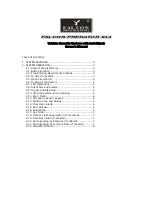
In family living units with more than one bedroom area or with bedrooms
on more than one floor, more than one smoke alarm will be needed, as
shown in Figure 2.
In addition to smoke alarms outside of the sleeping areas, NFPA 72
requires the installation of a smoke alarm on each additional story of the
family living unit, including the basement. These installations are shown in
Figure 3. The living area smoke alarms should be installed in the living
room or near the stairway to the upper level, or in both locations. The
basement smoke alarm should be installed in close proximity to the stair-
way leading to the floor above. When installed on an open joisted ceiling,
the alarm should be placed on the bottom of the joists. The alarm should
be positioned relative to the stairway so as to intercept smoke coming
from a fire in the basement before the smoke enters the stairway.
IMPORTANT CONSIDERATION
We recommend replacing your alarm(s) every ten (10) years; why:
·
Dust, dirt, and other environmental contaminants can affect your alarm over
a prolonged period.
·
Fast changing industry consensus standards and codes on all alarms
make it advisable to periodically upgrade your alarm to maximize life
safety.
·
Assurance that your smoke alarm needs are kept abreast with the con-
stantly improving electronic technology.
·
Smoke alarms are recognized as one of the lowest cost ways to protect
dwelling inhabitants against the danger of fire(s). It makes good com-
mon sense to periodically replace and update your smoke alarm that
contributes so much to life safety.
MOUNTING LOCATION
This smoke alarm can be mounted on a ceiling or wall with equal effi-
ciency in either location.
·
Ceiling locationalarm should be mounted as close as possible to the
center of a hallway or room. If this is not possible, the edge of the alarm
should be at least 4 inches from any wall.
·
Wall locationlocate the top of the alarm at least 4 inches and not more
than 12 inches from the ceiling.
Figure 4: RECOMMENDED SMOKE ALARM MOUNTING LOCATIONS
Figure 1: A SMOKE ALARM SHOULD BE LOCATED BETWEEN THE SLEEP-
ING AREA AND THE REST OF THE FAMILY LIVING UNIT.
Where to Locate the Required Smoke Alarms in New Construction.
All of the smoke alarms specified for existing construction are required,
and, in addition, a smoke alarm is required in each bedroom.
Are More Smoke Detectors Desirable?
The required number of smoke
alarms may not provide reliable early warning protection for those areas
separated by a door from the areas protected by the required smoke alarms.
For this reason, it is recommended that the householder consider the use
of additional smoke alarms for those areas for increased protection. The
additional areas include: basement, bedrooms, dining room, furnace room,
utility room and hallways not protected by the required smoke alarms. The
installation of smoke alarms in kitchens, attics (finished or unfinished), or
garages is not normally recommended, as these locations occasionally
experience conditions that can result in improper operation.
Figure 2: IN FAMILY LIVING UNITS WITH MORE THAN ONE SLEEPING
AREA, A SMOKE ALARM SHOULD BE PROVIDED TO PROTECT EACH
SLEEPING AREA IN ADDITION TO ALARMS REQUIRED IN BEDROOMS.
Figure 3: A SMOKE ALARM SHOULD BE LOCATED ON EACH STORY.
Figure 5: RECOMMENDED SMOKE ALARM LOCATION IN ROOMS WITH
SLOPED, GABLED, OR PEAKED CEILINGS.
The placement of the alarm is critical if maximum speed of fire detec-
tion is desired. Thus, a logical location for an alarm is the center of the
ceiling. At this location, the alarm is closest to all areas of the room.
WHERE SMOKE ALARMS SHOULD BE PUT IN
MOBILE HOMES
In mobile homes built after about 1978 that were designed and insu-
lated to be energy-efficient, smoke alarms should be installed as described
in the section above.
In older mobile homes that have little or no insulation compared to
todays standards, uninsulated metal outside walls and roofs can transfer
heat and cold from outdoors, making the air right next to them hotter or
colder than the rest of the inside air. These layers of hotter or colder air
can prevent smoke from reaching a smoke alarm. Therefore, put smoke
alarms in such units only on inside walls, between 4 and 12 inches (10
and 30 cm) from the ceiling. If you are not sure about the insulation level
in your mobile home, or if you notice that the walls or ceiling are unusually
hot or cold, put the alarm on an inside wall.
























